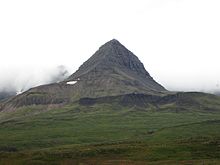Skarðsheiði
| Skarðsheiði | ||
|---|---|---|
|
Skarðsheiði in the background |
||
| height | 1054 m | |
| location | Iceland | |
| Coordinates | 64 ° 28 ′ 48 ″ N , 21 ° 39 ′ 0 ″ W | |
|
|
||
| Type | cold volcano | |
| Last eruption | approx. 4 million years ago (inactive) | |
| Normal way | on the south side | |
|
Skarðsheiði in the background, Skessuhorn in the middle, Heiðarhorn slightly hidden by the mountain Brekkufjall on the right, seen from Hvanneyri |
||
The mountain Skarðsheiði is a cold volcano in Iceland . It is located in the Borgarfjörður region in the west of the country on the southwest side of Lake Skorradalsvatn and is 1054 m high. The mountain is in the municipality of Skorradalur and Hvalfjarðarsveit .
The central volcano
The mountain, together with the neighboring lower massif of Hafnarfjall, is the remnant of a large central volcano that was active around 5.5 to 4 million years ago. There are four different eruption phases of the volcano: the first on Brekkufjall , the second on Hafnarfjall, the third on Skarðsheiði itself, the fourth on Heiðarhorn (Skarðsheiði). In the first phase more basaltic material was ejected , in the second intermediate and finally rhyolite material . During the third phase there was also the production of pyroclastic currents , traces of which can be found among others. a. at Andakíll can be seen as very ferrous and therefore reddish ignimbrite . It is believed that basaltic magma penetrated the chamber filled with rhyolite magma, causing overheating, as well as the production and ejection of the ignimbritic material.
Outstanding peaks
Two peaks are especially famous on Skarðsheiði. One is the main peak of the massif, the Heiðarhorn , which is also the highest point. The other is about a sub-peak of pyramidal shape protruding in the direction of Hvanneyri . It is a popular destination for climbers and mountaineers and is called the Skessuhorn . It is part of an old caldera .
The mountains were cut into this shape by the glaciers of the Ice Age , which shaved off around 1,500 meters of rock in Borgarfjörður.
Name Skessuhorn
Skessa is an old Icelandic term for a troll woman . There are many folk tales that tell of troll women who sat on the two peaks of Skessuhorn and Heiðarhorn, caught and ate people and threw stones at churches.
Old and new transport connections
Several old roads lead over high valleys and Háls towards Hvalfjörður . Again, similar to z. B. on Snæfellsnes , around Dritvík , was in earlier times from camp-like tent villages, so-called verbúðir , in row boats to fish. To do this, the farmers sent the servants that were superfluous in winter to other parts of the country. Such journeys by poor people, for example from North Iceland to Hvalfjörður, poorly equipped with clothes and shoes, took their toll, including on human lives.
And that too may be behind the legends of the troll women.
Nowadays, an unpaved pass road leads over the Dragháls in the north of the mountain range, first into Svínadalur behind and then further into Hvalfjörður.
The paved road 53, on the other hand, provides the connection between Reykholtsdalur and Borgarnes .
Hiking and mountaineering
You can hike on the old connecting paths across the high valley between Hafnarfjall and Skarðsheiði. There are also many opportunities for hiking in Skorradalur . A day tour takes you on the old Síldarmannagata (German: the way of the herring fishermen ) over to Hvalfjörður or further to Þingvellir .
There are many opportunities for climbing and mountaineering on Skarðsheiði, both from the south side and from the Dragháls Pass.
See also
Web links
- Hjalti Franzson: An Ignimbrite Cone-Sheet Feeder in The Hafnarfjall-Skarðsheiði Central Volcano, W-Iceland , in: George PL Walker Symposium on Advances in Volcanology, International Association of Volcanology and Chemistry of the Earths Interior (IAVCEI), Reykholt, Borgarfjordur, 12-17 June 2006, p.55 (About the central volcano Hafnarfjall - Skarðsheiði) (Abstract, English)
- L. Kristjánsson, ea: Paleomagnetic studies in Skarðsheiði, South-Western Iceland. Jökull 50 , 33-48, 2001. (Abstract, English)
Individual evidence
- ↑ Freysteinn Sigurðsson: Borgarfjarðarhérað milli Mýra og Hafnarfjalla (= Ferðafélag Íslands. Árbók 2004). Ferðafélag Íslands, Reykjavík 2005, ISBN 9979-9499-9-6 , p. 72.



